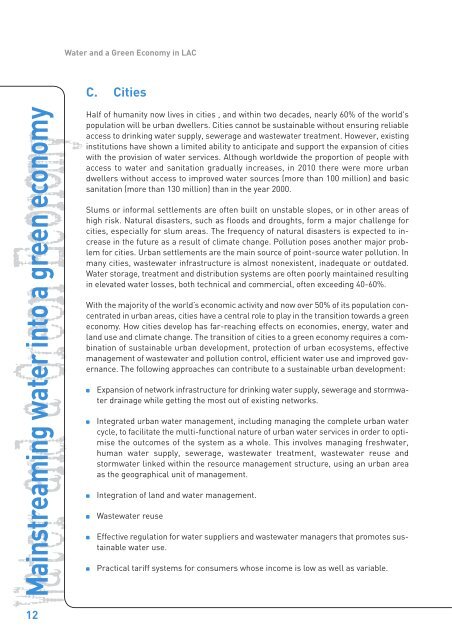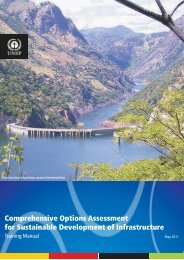Water and a Green Economy in Latin America and the Caribbean
Water and a Green Economy in Latin America and the Caribbean
Water and a Green Economy in Latin America and the Caribbean
Create successful ePaper yourself
Turn your PDF publications into a flip-book with our unique Google optimized e-Paper software.
<strong>Water</strong> <strong>and</strong> a <strong>Green</strong> <strong>Economy</strong> <strong>in</strong> LAC<br />
C. Cities<br />
<strong>Water</strong><strong>and</strong>a<strong>Green</strong><strong>Economy</strong><br />
Ma<strong>in</strong>stream<strong>in</strong>g water <strong>in</strong>to a green economy<br />
12<br />
Half of humanity now lives <strong>in</strong> cities , <strong>and</strong> with<strong>in</strong> two decades, nearly 60% of <strong>the</strong> world's<br />
population will be urban dwellers. Cities cannot be susta<strong>in</strong>able without ensur<strong>in</strong>g reliable<br />
access to dr<strong>in</strong>k<strong>in</strong>g water supply, sewerage <strong>and</strong> wastewater treatment. However, exist<strong>in</strong>g<br />
<strong>in</strong>stitutions have shown a limited ability to anticipate <strong>and</strong> support <strong>the</strong> expansion of cities<br />
with <strong>the</strong> provision of water services. Although worldwide <strong>the</strong> proportion of people with<br />
access to water <strong>and</strong> sanitation gradually <strong>in</strong>creases, <strong>in</strong> 2010 <strong>the</strong>re were more urban<br />
dwellers without access to improved water sources (more than 100 million) <strong>and</strong> basic<br />
sanitation (more than 130 million) than <strong>in</strong> <strong>the</strong> year 2000.<br />
Slums or <strong>in</strong>formal settlements are often built on unstable slopes, or <strong>in</strong> o<strong>the</strong>r areas of<br />
high risk. Natural disasters, such as floods <strong>and</strong> droughts, form a major challenge for<br />
cities, especially for slum areas. The frequency of natural disasters is expected to <strong>in</strong>crease<br />
<strong>in</strong> <strong>the</strong> future as a result of climate change. Pollution poses ano<strong>the</strong>r major problem<br />
for cities. Urban settlements are <strong>the</strong> ma<strong>in</strong> source of po<strong>in</strong>t-source water pollution. In<br />
many cities, wastewater <strong>in</strong>frastructure is almost nonexistent, <strong>in</strong>adequate or outdated.<br />
<strong>Water</strong> storage, treatment <strong>and</strong> distribution systems are often poorly ma<strong>in</strong>ta<strong>in</strong>ed result<strong>in</strong>g<br />
<strong>in</strong> elevated water losses, both technical <strong>and</strong> commercial, often exceed<strong>in</strong>g 40-60%.<br />
With <strong>the</strong> majority of <strong>the</strong> world’s economic activity <strong>and</strong> now over 50% of its population concentrated<br />
<strong>in</strong> urban areas, cities have a central role to play <strong>in</strong> <strong>the</strong> transition towards a green<br />
economy. How cities develop has far-reach<strong>in</strong>g effects on economies, energy, water <strong>and</strong><br />
l<strong>and</strong> use <strong>and</strong> climate change. The transition of cities to a green economy requires a comb<strong>in</strong>ation<br />
of susta<strong>in</strong>able urban development, protection of urban ecosystems, effective<br />
management of wastewater <strong>and</strong> pollution control, efficient water use <strong>and</strong> improved governance.<br />
The follow<strong>in</strong>g approaches can contribute to a susta<strong>in</strong>able urban development:<br />
Expansion of network <strong>in</strong>frastructure for dr<strong>in</strong>k<strong>in</strong>g water supply, sewerage <strong>and</strong> stormwater<br />
dra<strong>in</strong>age while gett<strong>in</strong>g <strong>the</strong> most out of exist<strong>in</strong>g networks.<br />
Integrated urban water management, <strong>in</strong>clud<strong>in</strong>g manag<strong>in</strong>g <strong>the</strong> complete urban water<br />
cycle, to facilitate <strong>the</strong> multi-functional nature of urban water services <strong>in</strong> order to optimise<br />
<strong>the</strong> outcomes of <strong>the</strong> system as a whole. This <strong>in</strong>volves manag<strong>in</strong>g freshwater,<br />
human water supply, sewerage, wastewater treatment, wastewater reuse <strong>and</strong><br />
stormwater l<strong>in</strong>ked with<strong>in</strong> <strong>the</strong> resource management structure, us<strong>in</strong>g an urban area<br />
as <strong>the</strong> geographical unit of management.<br />
Integration of l<strong>and</strong> <strong>and</strong> water management.<br />
Wastewater reuse<br />
Effective regulation for water suppliers <strong>and</strong> wastewater managers that promotes susta<strong>in</strong>able<br />
water use.<br />
Practical tariff systems for consumers whose <strong>in</strong>come is low as well as variable.

















